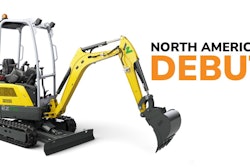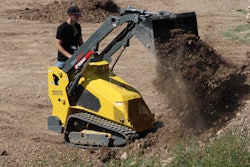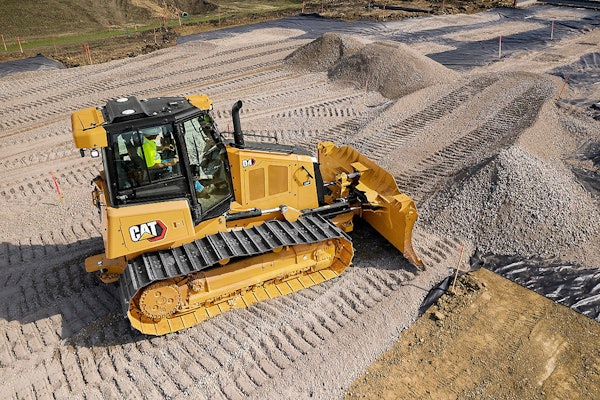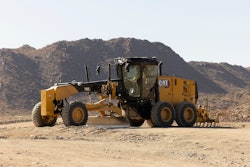Wacker Neuson is well-known in the U.S. for its rammers and compactors, but it’s also quietly been building a name for itself in the ride-on compact equipment market, with its skid steers, compact track loaders and mini excavators.
On this episode of The Dirt, we delve deeper into the company’s compact equipment in an interview with John Dotto, Wacker Neuson product application and training specialist.
One of the first things you’ll learn is how to pronounce “Neuson” – most Americans get it wrong.
But on a more serious note, Dotto explains what distinguishes the brand’s equipment, highlighting such attributes as simple design, easy maintenance, no diesel particulate filter and heavy-duty hardware for reliability.
So check out this episode of The Dirt to learn more about what Wacker Neuson has been up to on its compact equipment lines.
Equipment World serves up weekly videos on the latest in construction equipment, work trucks and pickup trucks – everything contractors need to get their work done. Subscribe and visit us at equipmentworld.com!
In This Episode:
00:00 - Wacker Neuson CTL and Mini Excavator Lineup
00:29 - Is Wacker Neuson Well Known for CTLs and Mini Excavators?
01:51 - What Are the Pros and Cons of Joining the Compact Equipment Space So Late?
03:45 - Serviceability of Wacker Neuson CTLs
06:20 - Operator Visibility in the New ST27 Wacker Neuson CTL
07:30 - How Do Wacker Neuson CTLs Avoid Having a DPF?
10:56 - Wacker Neuson Mini Excavator History
11:38 - The Advantages of Wacker Neuson Mini Excavators
14:08 - Final Thoughts
Wacker Neuson is well-known in the U.S. for its rammers and compactors, but it’s also quietly been building a name for itself in the ride-on compact equipment market, with its skid steers, compact track loaders and mini excavators. On this episode of The Dirt, we delve deeper into the company’s compact equipment in an interview with John Dotto, Wacker Neuson product application and training specialist. One of the first things you’ll learn is how to pronounce “Neuson” – most Americans get it wrong. But on a more serious note, Dotto explains what distinguishes the brand’s equipment, highlighting such attributes as simple design, easy maintenance, no diesel particulate filter and heavy-duty hardware for reliability. So check out this episode of The Dirt to learn more about what Wacker Neuson has been up to on its compact equipment lines. Equipment World serves up weekly videos on the latest in construction equipment, work trucks and pickup trucks – everything contractors need to get their work done. Subscribe and visit us at equipmentworld.com! Newsletter Signup: https://randallreilly.dragonforms.com/loading.do?omedasite=eqw_subscriptions In This Episode: 00:00 - Wacker Neuson CTL and Mini Excavator Lineup 00:29 - Is Wacker Neuson Well Known for CTLs and Mini Excavators? 01:51 - What Are the Pros and Cons of Joining the Compact Equipment Space So Late? 03:45 - Serviceability of Wacker Neuson CTLs 06:20 - Operator Visibility in the New ST27 Wacker Neuson CTL 07:30 - How Do Wacker Neuson CTLs Avoid Having a DPF? 10:56 - Wacker Neuson Mini Excavator History 11:38 - The Advantages of Wacker Neuson Mini Excavators 14:08 - Final Thoughts
Bryan Furnace (00:00):
Today we are here to talk about Wacker Neuson, and we're here to talk about their new CTL and mini lineup that you may have been seeing here and there. Wacker's, not just good for the Wacker packer, they're here for your compact equipment as well. But that being said, we're going to flip over and we're going to talk to John Dotto about the new lineup. For a lot of us on the job sites, Wacker Neuson is kind of known as the support equipment, you've got the jumping jacks and the plate compactors and a lot of that support equipment. How do you think that's impacted you guys as you've moved over into the CTL and mini space?
John Dotto (00:43):
I think it's been great for us as we've moved into compact equipment. So a lot of guys are used to looking for the Wacker packer, so it's not like we're an unknown name on the job site, and we've been around for a long, long time. So we've been doing business for 175 years. We've been in North America since 1957. And with that core product, those like you, you mentioned, your plate compactors, your jumping jacks, your rammers, that stuff has been all around North American job sites for a really long time and with a super high level of a reputation of quality and longevity. So as we've moved into the compact equipment space with skid-steers, CTLs, wheel loaders, tele handlers, I know today we're going to talk about CTLs and mini excavators for the most part.
(01:30):
But I think it's only helped when we make that connection for the contractor to say, oh yeah, that Wacker Neuson mini, that's the same company that the logo fell off my plate tamper 10 years ago and I'm still running it. So I think it's been really helpful for us to have that image of quality on a job site for a really long time.
Bryan Furnace (01:50):
Coming into the compact equipment market this late in the game. I know there are advantages to being a late mover, but there's also some really good advantages of setting yourself up in the marketplace, being one of those first guys to market. How do you think that's kind of impacted you guys coming into that compact market this late in the game?
John Dotto (02:08):
Well, you've got a really good understanding of the fact that there are advantages and disadvantages. So a couple of the advantages are you're able to learn from your competitors, you're able to see what's been done and what's worked in the past. For us, specifically on the compact track loader, and the skid-steer loader line with where we came into market in relation to when Tier 4 final engine emissions regulations went live, we were able to design a chassis that made the space for all the aftertreatment systems and didn't have to try and cram a bunch of equipment into an engine compartment. So that was for sure an advantage.
(02:45):
In terms of disadvantages, yeah, it's a crowded market. So to try to make yourself known in a very, very crowded space, especially if you're talking about those two things we're talking about today, skid-steer, CTLs and mini excavators, the number of competitors that are out there is really large. But I think that goes back to what we talked about at the very beginning. We're not an unknown brand, we're just lesser known for some of the compact equipment. So that's where we really had to lean into our brand recognition on the compaction side of things. And I think so far it's working really well. And at the end of the day, if you have a quality product and you're known for quality, that's what customers are looking for.
Bryan Furnace (03:22):
Well, 100%. So I will 100% honesty. We were at one of the shops the other day picking up some concrete tools and a couple of your products were sitting out there, some of the new minis and CTLs, and we absolutely went over and took a look because as you've stated, you guys are a known name in the industry, just not necessarily for compact equipment. So it kind of automatically stirs that curiosity of, hey, let's go take a look at what they've got. But that being said, let's get into your CTL. Let's get into being a late mover coming into the market, that has clearly given you some advantages on your design, like you stated. What are some of the advantages you guys have over some of the competitors already out in the market?
John Dotto (03:59):
Yeah, number one for us has always been serviceability. So when you open up the engine compartment, when you flip open the cooling package, when you tip the cab, when you look at the machine completely wide open, you can see a total difference in just the simplicity of the design that we were able to use because you started knowing you were going to need space for after treatment systems, and then designing your machine to include these after treatment systems at the beginning of design meant that we weren't putting extra equipment where there wasn't before. So you'll see in some other manufacturers' designs that haven't made a generation shift, you see a lot of extra equipment crammed into these engine compartments, and it just makes it really, really tough to work on. So for me, one of our number one selling aspects and one of the number one things that really differentiates us is that serviceability.
(04:50):
So I always say if a lot of our dealers will go out to state fairs or little local trade shows, I say, if you've got one machine to show off, open it up tip the cab. If they want to sit in the cab, make them come on site and get a demo from you but really the best thing we can show customers is that simplicity of design because we were never in the market before Tier 4 final. So the entire thing was designed for all of the modern necessities that are in our systems.
Bryan Furnace (05:17):
I will say that's a great point because a lot of the manufacturers did exactly what you just said. It was, we've got our chassis, we have our setup. Oh, here comes all of this after treatment system, we're going to have to reshuffle the guts. We're not going to redesign the actual frame of the machine, we're just going to reshuffle the guts. I mean, everyone in the industry knows you pop open the back of a skid-steer these days and you can't hardly fit your fingers in there because so jam-packed full of equipment. So I could see where that's a complete advantage.
John Dotto (05:44):
One of the things that you won't see, you won't see stuff routed on the belly, you won't see... Because that's the thing is, like you said, reshuffling. So nothing that has been moved in some of the competitor's machines is not necessary. So they just had to find different places for it, and it just becomes a less than ideal situation. And what we've got is we've got all of our critical components are up off the belly of the machine. We still have huge belly clean-outs because we weren't trying to put fixtures for things that we're routing around the belly of the machine. So yeah, I do think that it's an incredible competitive advantage for us from that serviceability standpoint.
Bryan Furnace (06:20):
Well, I will say one thing that got me excited about trying out one of your machines is through the chassis design, you guys were able to get your boom arms a little lower down. That's got to be pretty impactful on the visual side.
John Dotto (06:29):
So that's something that you're going to see on our brand new ST27. So we launched the ST27 publicly at CONEXPO this year, and it's our first uni-body track loader design. So that means that the undercarriage is part of the chassis. On the previous generations, we use some commonality between the loader arms, not necessarily the chassis itself. So a compact track loader doesn't have a chain tank like a skid-steer loader does. So we do have unique lower chassis for the previous generation designs. But as we move forward, we've got this new uni-body design, and when you're dedicating yourself to a track loader, you are able to kind of hug the loader arms down over the tops of the tracks, which does allow you to lower the profile of the arms. And like you say, the main advantage of that is invisibility, visibility out of the side. And it also allows us to keep the loader arms a little bit wider where the door opens. So yeah, there's some pretty nice visibility advantages to the ST27's uni-body design.
Bryan Furnace (07:29):
And one last point that really got me excited is you guys have been able to avoid the plague of the DPF, if I understand correctly.
John Dotto (07:38):
Correct.
Bryan Furnace (07:38):
How are you guys able to do that when so many people are stuck with DPFs?
John Dotto (09:05):
Yeah, so when we started designing the machines as we got into our medium frame loaders and we got into our second generation of large frame loaders, the engine manufacturer that we work with to power the machines is Kohler. And we use a few different model numbers, but they're a Kohler KDI. So that stands for Kohler Direct Injection. And the after treatment system that we use is a DOC only. So DOC stands for Diesel Oxidation Catalyst. And the way we're able to meet emissions regulations using just the DOC is through the high-tech fuel injection system. So those Kohler KDIs, they're high pressure common rail fuel injection is happening at 30,000 PSI.
Bryan Furnace (09:47):
Wow.
John Dotto (09:47):
Yeah. So the higher you can get the pressure of the fuel injected in the cylinders, the more finally you are atomizing that fuel as it's in cylinder. So what you end up with is a really clean burn. What a particulate filter does is it takes a dirty burn and it cleans up the particulate matter because that's one of the things that the EPA wants to keep out of the air. So you can avoid needing a particulate filter if you use this finely atomized diesel fuel and you leave little to, none of it unburnt to be caught by a filter. So a DOC meets those Tier 4 final engine emissions regulations, and it doesn't do that thing that the filter does because if you've been on those machines, the filters plug up and then they go through the regen cycles.
Bryan Furnace (10:30):
It's miserable.
John Dotto (10:31):
And then as your equipment gets a little older, your regen cycles come more and more and more often because you're losing the airspace in the canister.
Bryan Furnace (10:39):
And sensor issues inevitably and injector issues inevitably, and...
John Dotto (10:45):
All sorts of issues. And all of those issues cost you money to fix and in downtime on your machine because when any part of your aftertreatment system isn't working, you're on a paper weight.
Bryan Furnace (10:55):
Absolutely. Well, let's shift gears now. Let's talk about your mini excavator lineup. What have you guys brought to market and what's giving you kind of a competitive advantage in that space?
John Dotto (11:04):
On the mini ex side, again, we've maybe been in business longer than a lot of North America has known. So the Wacker Neuson Group consists of a few different brand names sold globally. Here in North America, we are Wacker Neuson but the Neuson part of Wacker Neuson has been building mini excavators in Germany since 1984. That's when we actually built our first mini excavator.
Bryan Furnace (11:25):
Wow.
John Dotto (11:26):
Yeah. So we've got several decades of experience building mini excavators, and we started bringing them to North America in the early two thousands when the Wacker Neuson group was founded. And so we had a ton of experience there. And what you'll see on our excavators that's a little different than most of our competition is sometimes we want to get ourselves away from the German engineering phrase, but that's really what you do see on the mini excavator product, although they're built in Austria. So, sh. But still.
Bryan Furnace (11:52):
Well, let's be honest though. Can anyone say they build their mini in the US these days?
John Dotto (11:59):
That's a good question. Well, pretty soon, yeah. There are some people that could say they do.
Bryan Furnace (12:04):
They're moving that way. But that's a rough market to say you're domestic.
John Dotto (12:07):
Yeah.
(12:07):
What you'll see is if you just look at our machines versus some of the competitors that are out there, I always tell customers, or our dealer sales guys, when I'm training them, look at the size of the dozer blade, the construction of the dozer blade. You'll see a big robust dozer blade. In some cases, we've got replaceable cutting edges on the dozer blades. Look at the way we've guarded the cylinder down there. Look at how we've wrapped the hoses down there. So all of it's like top-notch heavy stuff. And then you get into some of the hardware we use. Some of the castle nuts we use for fixtures, for bucket pins, et cetera, you don't see that type of hardware on excavators until typically you get into about the 16 ton class for most people. And we've got that kind of hardware, now it's scaled down, but on our 1.7 ton minis that we've got, so really it's just a build quality thing.
(12:53):
We also started in North America primarily putting those machines into rental markets. And what those rental yards found was that because of the size of the components that we're using, because of the quality, the hardware, the size of the pins, the style of the bushings, they just don't wear out over time the way that some other machines might under that tough rental application. And the Austrians, they design it also to be used on a breaker for eight hours a day. So that's how we engineer the hydraulic system. That's how we engineer bucket and boom pins to be under the stress of a breaker for eight hours a day. So the result is a machine that stays really nice and tight for a long time.
Bryan Furnace (13:32):
I was going to say that's pretty critical because one of the short fallings of the mini market is when you start putting really labor heavy attachments on those things, they tend to lose steam pretty quick. So it's nice to hear that you guys are engineering specifically for that.
John Dotto (13:48):
Yeah. And we want to make sure that those hydraulic systems stay nice and cool under those intense applications. So the mini excavator product has long been, they're all crown jewels, but it's definitely a great product that we build.
Bryan Furnace (13:59):
Well, John, thank you so much for the time. Thank you for all the information. And I'm going to be honest, I'm kind of excited to sit in the seat of one of these new machines and give it a couple whirls around the job site.
(14:08):
Well, thank you again for John coming on the show to talk about the new CTL and mini lineup that Wacker Neuson has brought to market. And I'm going to be honest, as a contractor, I'm intrigued. I think I'm going to go take a look at one of these new units, especially when you start talking about better visibility and the fact that it was designed to have all of the after treatment stuff, but that after treatment stuff doesn't necessarily include a DPF. Those are all three big positives in my mind. So as always, we hope this has helped your business. Thanks for watching. We'll catch you on the next episode of The Dirt.









